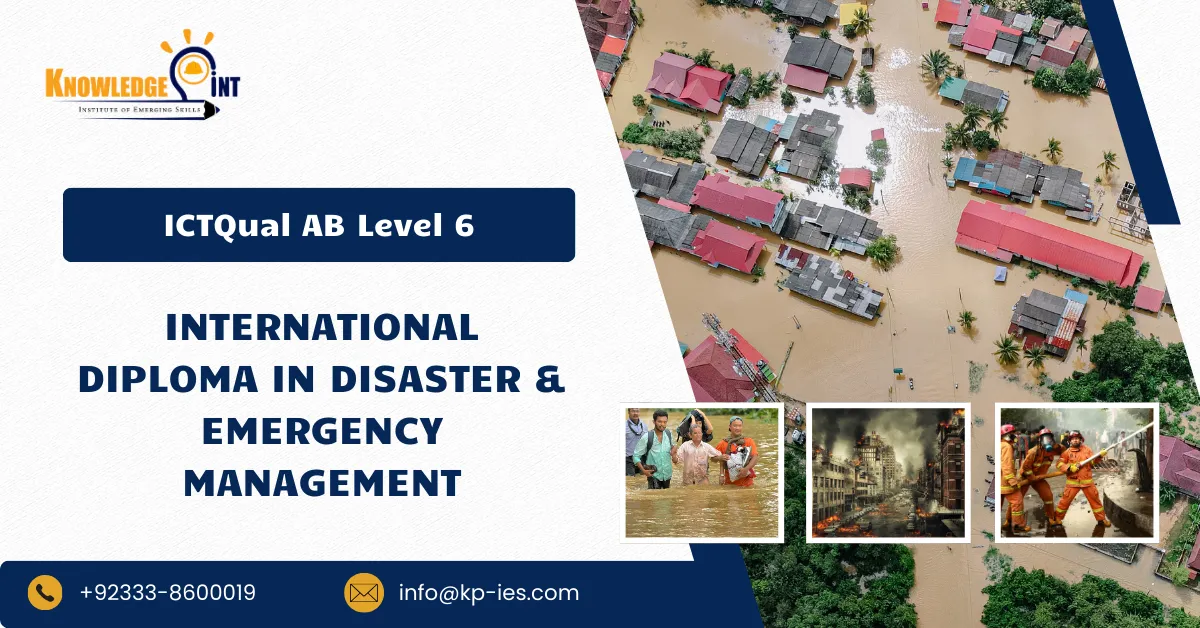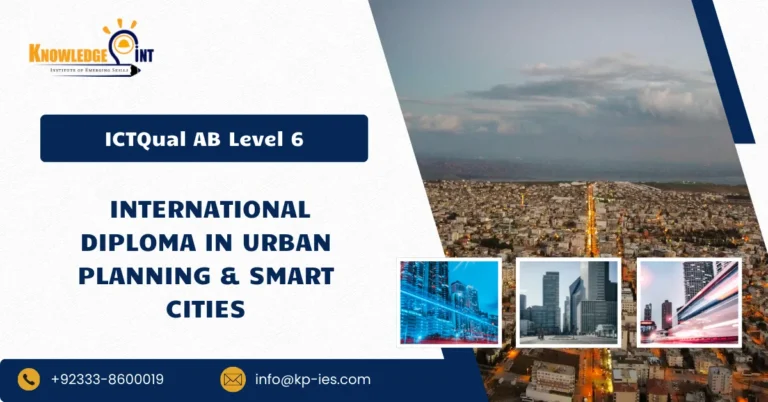The ICTQual AB Level 6 International Diploma in Disaster & Emergency Management is a comprehensive three-year, 360-credit programme designed to equip learners with advanced knowledge, skills, and practical expertise in managing disasters and emergency situations. This qualification is ideal for individuals seeking to develop strategic, operational, and leadership capabilities in disaster preparedness, response, recovery, and resilience planning.
Learners will explore disaster risk management, emergency response strategies, crisis communication, business continuity, and resilience frameworks. The programme integrates theoretical instruction with practical applications, including case studies, simulation exercises, and applied projects, enabling learners to develop critical thinking, decision-making, and leadership skills essential for effective emergency management.
This programme caters to both fresh learners and experienced professionals. Fresh learners will build a solid foundation in disaster management principles, emergency planning, and risk assessment, progressing to advanced operational and strategic skills throughout the three-year programme. Experienced professionals can leverage their prior knowledge and work experience to enhance expertise, lead complex emergency response operations, and contribute to organisational and community resilience initiatives.
Course Overview
This qualification, the ICTQual AB Level 6 International Diploma in Disaster & Emergency Management, consists of 36 mandatory units.
Year 1 – Foundations of Disaster & Emergency Management
- Introduction to Disaster and Emergency Management
- Types and Causes of Disasters
- Principles of Risk Assessment and Management
- Emergency Planning and Preparedness
- Crisis Communication and Stakeholder Engagement
- Introduction to Humanitarian Response
- Disaster Legislation, Policies, and Governance
- Environmental Impacts of Disasters
- Resource Management in Emergency Situations
- Introduction to Project Management in Disaster Response
- Health and Safety in Disaster Management
- Ethical Considerations in Emergency Operations
Year 2 – Applied Disaster & Emergency Management Practices
- Advanced Risk Assessment and Vulnerability Analysis
- Disaster Mitigation Strategies
- Emergency Operations and Response Coordination
- Incident Command Systems and Leadership
- Humanitarian Logistics and Supply Chain Management
- Community Preparedness and Awareness Programmes
- Disaster Recovery and Rehabilitation Planning
- Crisis Management for Organisations and Institutions
- Use of Technology and Digital Tools in Disaster Management
- Environmental Sustainability in Disaster Operations
- Applied Research Methods in Disaster Management
- Operational Planning and Simulation Exercises
Year 3 – Strategic Leadership in Disaster & Emergency Management
- Strategic Leadership in Disaster Management
- International Disaster Management Frameworks and Standards
- Policy Development and Regulatory Compliance
- Advanced Crisis and Risk Communication
- Disaster Resilience and Business Continuity Planning
- Climate Change and Disaster Risk Reduction
- Emergency Preparedness for Critical Infrastructure
- Governance, Ethics, and Accountability in Disaster Management
- Innovation and Emerging Technologies in Emergency Response
- Strategic Planning and Resource Mobilisation
- Independent Research Project in Disaster & Emergency Management
- Capstone Project: Applied Disaster & Emergency Management
Learning Outcomes for the ICTQual AB Level 6 International Diploma in Disaster & Emergency Management Studies 360 Credits – Three Years:
Year 1 – Foundations of Disaster & Emergency Management
1. Introduction to Disaster and Emergency Management
- Explain the fundamental concepts, objectives, and scope of disaster and emergency management.
- Identify key stakeholders and their roles in disaster response.
2. Types and Causes of Disasters
- Analyse natural, technological, and human-induced disasters.
- Assess the primary causes and potential impacts of various disaster types.
3. Principles of Risk Assessment and Management
- Conduct basic risk assessments for organisations and communities.
- Develop strategies to mitigate and manage potential hazards.
4. Emergency Planning and Preparedness
- Design emergency preparedness plans for different scenarios.
- Identify resources, roles, and responsibilities in emergency planning.
5. Crisis Communication and Stakeholder Engagement
- Develop effective communication strategies during emergencies.
- Engage stakeholders to support disaster preparedness and response.
6. Introduction to Humanitarian Response
- Explain the principles of humanitarian aid and disaster relief.
- Evaluate organisational structures involved in emergency humanitarian support.
7. Disaster Legislation, Policies, and Governance
- Analyse national and international disaster management legislation.
- Apply governance frameworks to ensure compliance and ethical practice.
8. Environmental Impacts of Disasters
- Assess environmental consequences of disasters.
- Propose measures to reduce ecological damage during and after emergencies.
9. Resource Management in Emergency Situations
- Manage personnel, equipment, and logistical resources effectively.
- Prioritise resources according to disaster severity and operational needs.
10. Introduction to Project Management in Disaster Response
- Plan and execute small-scale disaster management projects.
- Monitor project performance and ensure alignment with objectives.
11. Health and Safety in Disaster Management
- Identify health and safety risks in emergency operations.
- Implement measures to protect responders and affected communities.
12. Ethical Considerations in Emergency Operations
- Apply ethical principles in decision-making during disasters.
- Ensure accountability and transparency in disaster response activities.
Year 2 – Applied Disaster & Emergency Management Practices
1. Advanced Risk Assessment and Vulnerability Analysis
- Conduct in-depth risk assessments for communities and organisations.
- Identify vulnerabilities and propose targeted mitigation strategies.
2. Disaster Mitigation Strategies
- Develop and implement disaster mitigation plans.
- Evaluate the effectiveness of preventive measures and interventions.
3. Emergency Operations and Response Coordination
- Coordinate multi-agency disaster response operations.
- Apply incident command principles to ensure efficient resource use.
4. Incident Command Systems and Leadership
- Lead operational teams during emergencies using structured command systems.
- Make critical decisions under pressure to maintain operational effectiveness.
5. Humanitarian Logistics and Supply Chain Management
- Plan and manage logistics for relief distribution and emergency supplies.
- Optimise supply chain processes to enhance disaster response efficiency.
6. Community Preparedness and Awareness Programmes
- Design and deliver disaster awareness campaigns.
- Engage communities to promote preparedness and resilience.
7. Disaster Recovery and Rehabilitation Planning
- Develop recovery plans to restore infrastructure and services.
- Implement rehabilitation strategies for affected populations.
8. Crisis Management for Organisations and Institutions
- Develop organisational crisis management frameworks.
- Ensure business continuity during and after emergencies.
9. Use of Technology and Digital Tools in Disaster Management
- Utilise GIS, early warning systems, and digital tools for disaster monitoring.
- Analyse data to inform response planning and decision-making.
10. Environmental Sustainability in Disaster Operations
- Integrate sustainability principles into disaster response activities.
- Minimise environmental impact during operations and recovery.
11. Applied Research Methods in Disaster Management
- Apply research methodologies to evaluate disaster management practices.
- Analyse data to support evidence-based decision-making.
12. Operational Planning and Simulation Exercises
- Develop detailed operational plans for simulated disaster scenarios.
- Evaluate performance and identify areas for improvement.
Year 3 – Strategic Leadership in Disaster & Emergency Management
1. Strategic Leadership in Disaster Management
- Lead organisational strategies in disaster preparedness and response.
- Develop policies and procedures that enhance operational resilience.
2. International Disaster Management Frameworks and Standards
- Analyse international standards and frameworks in disaster management.
- Ensure organisational alignment with global best practices.
3. Policy Development and Regulatory Compliance
- Develop disaster management policies aligned with legislation.
- Monitor and enforce compliance with relevant regulations.
4. Advanced Crisis and Risk Communication
- Develop comprehensive crisis communication strategies.
- Manage communication across multiple channels and stakeholders.
5. Disaster Resilience and Business Continuity Planning
- Design strategies to enhance organisational and community resilience.
- Implement business continuity plans to minimise disruption during emergencies.
6. Climate Change and Disaster Risk Reduction
- Assess the impact of climate change on disaster risk.
- Develop adaptation and mitigation strategies to reduce vulnerability.
7. Emergency Preparedness for Critical Infrastructure
- Plan for the protection of critical infrastructure during disasters.
- Conduct risk assessments and implement mitigation measures.
8. Governance, Ethics, and Accountability in Disaster Management
- Apply ethical leadership and governance principles in emergency operations.
- Ensure transparency, accountability, and compliance in decision-making.
9. Innovation and Emerging Technologies in Emergency Response
- Evaluate and apply emerging technologies to enhance disaster management.
- Integrate innovative solutions to improve response efficiency and effectiveness.
10. Strategic Planning and Resource Mobilisation
- Plan large-scale emergency operations and allocate resources effectively.
- Coordinate multi-agency responses to complex disaster scenarios.
11. Independent Research Project in Disaster & Emergency Management
- Conduct independent research on a relevant topic in disaster management.
- Present findings and evidence-based recommendations for practical application.
12. Capstone Project: Applied Disaster & Emergency Management
- Integrate knowledge and skills from all units into a comprehensive applied project.
- Demonstrate strategic planning, operational execution, and leadership in disaster scenarios.
Course Benefits of ICTQual AB Level 6 International Diploma in Disaster & Emergency Management
- Provides comprehensive knowledge of disaster management principles, emergency planning, and crisis response strategies.
- Equips learners with skills to assess risks, plan for emergencies, and coordinate disaster response operations.
- Develops expertise in disaster preparedness, mitigation, recovery, and resilience planning.
- Enhances understanding of national and international disaster management frameworks, policies, and regulations.
- Offers practical experience through simulations, field exercises, and real-world emergency management case studies.
- Strengthens analytical, problem-solving, and decision-making skills for managing complex emergencies.
- Prepares learners for leadership and advisory roles in disaster management agencies, NGOs, and government organizations.
- Improves employability in emergency services, humanitarian organizations, disaster relief agencies, and public safety departments.
- Promotes adherence to ethical practices, community-focused response, and safety standards.
- Supports continuous professional development and specialization in advanced disaster and emergency management practices.
After completing this course, learners can progress in the following ways:
- Pursue Master’s degrees in Disaster Management, Emergency Management, Risk and Resilience Studies, or Crisis Management.
- Obtain professional certifications such as Certified Emergency Manager (CEM), Disaster Risk Management Specialist, or Humanitarian Response Certification.
- Advance into senior roles such as Disaster Management Coordinator, Emergency Response Manager, Risk Assessment Consultant, or Crisis Management Director.
- Work with government disaster management agencies, international organizations, NGOs, emergency services, and humanitarian relief organizations.
- Progress into leadership and executive positions, overseeing disaster preparedness programs, emergency response teams, and crisis management strategies.
- Engage in research and development, contributing to disaster risk reduction, resilience planning, and innovative emergency response solutions.
- Transition into specialized areas such as natural disaster management, industrial disaster planning, public safety, or humanitarian logistics.







